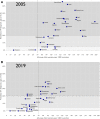World Malaria Day 2021: Commemorating 15 Years of Contribution by the United States President's Malaria Initiative
- PMID: 33891560
- PMCID: PMC8176495
- DOI: 10.4269/ajtmh.21-0432
World Malaria Day 2021: Commemorating 15 Years of Contribution by the United States President's Malaria Initiative
Abstract
World Malaria Day 2021 coincides with the 15th anniversary of the United States President's Malaria Initiative (PMI) and follows the first anniversary of the declaration of the coronavirus disease (COVID-19) pandemic. From 2006 to the present, the PMI has led to considerable country-managed progress in malaria prevention, care, and treatment in 24 of the highest-burden countries in sub-Saharan Africa and three countries in the Southeast Asia Greater Mekong subregion. Furthermore, it has contributed to a 29% reduction in malaria cases and a 60% reduction in the death rates in sub-Saharan Africa. In this context of progress, substantial heterogeneity persists within and between countries, such that malaria control programs can seek subnational elimination in some populations but others still experience substantial malaria disease and death. During the COVID-19 pandemic, most malaria programs have shown resilience in delivering prevention campaigns, but many experienced important disruptions in their care and treatment of malaria illness. Confronting the COVID-19 pandemic and building on the progress against malaria will require fortitude, including strengthening the quality and ensuring the safety and resiliency of the existing programs, extending services to those currently not reached, and supporting the people and partners closest to those in need.
Figures



References
-
- U.S. President’s Malaria Initiative , 15th Annual Report to Congress, 2021. Available at: https://www.pmi.gov/about/pmi-annual-report-2021. Accessed April 20, 2021.
-
- The U.S. President’s Malaria Initiative , 2007. Saving the Lives of Mothers and Children in Africa, First Annual Report, March 2007. Available at: https://www.pmi.gov/docs/default-source/default-document-library/pmi-rep.... Accessed April 16, 2021.
-
- WHO , 2020. World Malaria Report. Available at: https://www.who.int/docs/default-source/malaria/world-malaria-reports/97.... Accessed April 16, 2021.
MeSH terms
LinkOut - more resources
Full Text Sources
Other Literature Sources
Medical

